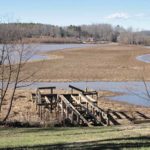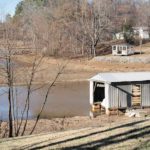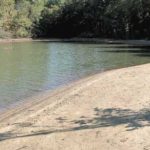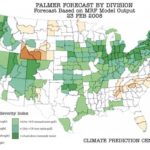
The 2007 drought affected access to water, changed lake habitats and often affected fish. If the same happens in 2008, recovery could take 10 years.
Jason Quinn, a Lake Wylie resident and a highly successful professional bass angler, called his wife last year to get information about North Carolina’s drought during a break at an Arkansas conference.
“My wife said all the boat ramps at Lake Wylie were closed,” he said, “all but one.”
It was bad news for Quinn, who makes the lake his playground when he’s not fishing for big cash prizes at national bass tournaments. Because of the long drought in the southeastern United States, water in Lake Wylie was so low that local and state officials agreed with Duke Energy to close the popular lake to boat access.
Of course, Lake Wylie wasn’t the only body of water affected by a year-long lack of rain. Severe drought extended from northern Georgia across central South Carolina and throughout the N.C. piedmont.
Bodies of water across North Carolina dropped drastically. Even after winter and early spring rains during 2008, the official classification by the National Weather Service this spring was the central part of the state still was suffering from drought conditions.
For anglers, what difference will the drought make this year?
“Short-term drought impacts this past summer were related to access,” said Catawba Riverkeeper Donna Lisenby. “Sixteen boat launches at seven Catawba River lakes were closed. All public launches at Lake James were closed and remain closed (by Jan. 22, 2008) because the lake was still 10 feet below full pond (the lake’s ramps were opened during February).
“That was bad news for smallmouth bass anglers because Lake James is one of the few Catawba River lakes that has a reliable smallmouth fishery.”
Still, fishing remained pretty good.
“Provided the record low lake levels on the Catawba system didn’t leave the boats of resident anglers stranded in the mud at the end of their docks, they enjoyed some good fishing last (2007) summer in lakes that had far less water to hide fish,” she said.
Local Lake Norman angler Buck Stikeleather caught a N.C.-record white crappie while he was fishing Dec. 9 at the northern end of Lake Norman.
“The basic theme I heard from anglers throughout the Catawba basin last summer was that low water levels made good fishing, provided you could get on the water,” she said.
Bob Curry, N.C. Wildlife Resources Commission Director of the Freshwater Fisheries, had concerns about the impact lower water levels in reservoirs would have on predator-prey relationships.
“There was a shift in the habitat of fish,” he said. “Shoreline species were driven closer to the center of the lake and that may have shifted the balance of how predator and prey species interacted.”
Assessing such a problem is difficult. William J. Matthews and Edie Marsh-Matthews of the University of Oklahoma reviewed studies of the impacts of drought on fish for freshwater fisheries. They found no studies that addressed comparable population dynamics.
Several research papers suggested drought affected competition dynamics, but none provided data to support the hypothesis. However, it’s clear for a 3-inch bluegill that had the misfortune to swim past a 10-pound striper in open water, the change would be dramatic.
Low water and reduced flows in streams may have had significant impact on some species. Some streams in southeast Mecklenburg County support populations of the endangered Carolina Heelsplitter, a small clam. If the streams with the Heelsplitter ran dry, the rare freshwater claim might become extinct.
“Away from the lakes, many tributaries in the Catawba watershed experienced record low levels and some streams dried up completely,” Lisenby said. “The N.C. Wildlife Resources Commission had to reduce trout stocking because of low water levels at the headwaters of trout streams of the Catawba and throughout western N.C.. Many coves on the Catawba River lakes also dried up as lake levels declined sharply. Feeder streams and shallow cove areas are important habitat and nursery areas for fish.”
The WRC has said it will compress 2008 trout stockings into the spring, but reduce them for the summer. The WRC will stock trout during March, April and May and reduce, though not eliminate, stockings during June and July. The goal of the compressed stockings is to minimize the continuing drought’s impact on hatchery fish.
Basically, it doesn’t do much good to stock trout, a cold-natured fish, into water that’s warm enough to boil them.
“With much of North Carolina in an exceptional drought and drought conditions forecast into the summer, the aquatic habitat and environmental conditions for hatchery-trout production likely will continue to decline,” said Kyle Briggs, the agency’s statewide hatchery production coordinator. “All the trout scheduled for stocking in 2008 will be stocked, but most will be stocked before July.
“Given the anticipated drought conditions, this is a proactive, rational and equitable plan to address our trout production and stocking program for the next two years.”
Chris Goudreau, a WRC fisheries biologist, noted the impact of reduced water flows upon aquatic habitat.
“In a general sense, reduced flows can alter aquatic habitat, which could lead to desiccation, predation, habitat fragmentation, etc.,” he said.
“Habitat fragmentation may occur when fish get trapped in a pool by (dropping) water (levels). If the pool eventually becomes dry, the fish die. Even if the pool remains watered, intense competition for resources will be likely. Low-water effects will be felt not only by the sportfish but other species as well.
“Thus, even if the sportfish have a good spawn, their food resources may be down, and they won’t make it to catchable size.”
Goudreau is particularly interested in the brown trout fishery in the Catawba River south of Lake James.
“In terms of the tailrace, our sampling last year in the first week of October didn’t reveal anything out of the ordinary,” he said. “Catch rates of all trout were down from the previous year … (but) were still within the (expected) range.
“We might see something different when we go out (in 2008) and observe cohort survival over the whole drought period. Additionally, we didn’t see any changes in condition or first-year growth last year.”
For the summer of 2008, Goudreau was optimistic.
“I’d say the biggest factor for the tailrace is the amount of water in Lake James,” he said. “Assuming there’s enough volume in the reservoir to ensure stratification and ample cold water, the limited releases could provide a more favorable temperature regime for trout in the tail race. However, should we run thin on storage volume, I would have to assume the tailrace has the potential to enter an unfavorable regime at a faster pace.”
What happens next?
The professors Matthews were unable to isolate long-term impacts of drought upon fish populations. Clearly, they noted, if a stream or pool runs dry, local populations will be affected.
“Although drought can have some effects on some individual species, drought alone is not an overriding or simplifying explanation for much that is evident in the extant fish assemblages of Midwest rivers,” they said.
In North Carolina, drought hasn’t necessarily meant disaster for fisheries.
“Sampling in smallmouth bass streams and rivers in District 8 showed the 2002 cohort was our strongest and 2002 was a drought year,” Goudreau said. “Based on this initial sample, it appears our riverine smallmouth are able to take advantage of low-water conditions.
“We won’t know for several years if the same thing — a good spawn and year class — is a result of the 2007 drought. Remember, the 2002 drought was followed by several years of average or better water. If the 2007 drought is followed by another year of drought, we aren’t sure that the good year class will manifest itself.”
Some of the long-term impacts of drought on the region’s fishery may be unrelated to low water or fish.
Up and down the Catawba River, the drought stimulated some long-term habitat destruction.
“Unfortunately, some thrill-seeking members of the public took advantage of low-water levels and began tearing up the lake beds with four-wheel drive vehicles,” Lisenby said. “The destruction of vulnerable fish habitat by record low-water levels or human thrill-seekers doesn’t bode well for the long-term health of the Catawba River fishery.
“I’m afraid the impacts of the 2007 drought will continue to extend beyond access issues and impact the health of the fisheries throughout the Catawba system. Long-term climatological models are predicting another dry spring and summer across the Southeast. If 2008 brings us another extremely dry spring and summer following on the heels of 2007’s second-driest year on record in the Catawba basin, then it’ll probably take more than a decade for the fishery to recover.”
In a parallel vein, Goudreau agreed North Carolina probably is sailing into unknown waters if more drought conditions occur this summer.
“I think that we are entering into an area that is somewhat uncharted — and filled with a lot of other non-drought noise — so time will likely provide the true answers,” he said.
By the end of February, many of the previously-closed boat launch sites had reopened.
At the Catawba River chain of lakes, anglers can determine the status of any of the launch sites by going to the Duke Energy web site (www.duke-energy.com). At the upper right quadrant of the home page there is an open box for searches. Enter “boat ramps” and click on “go.” The status of the boat access points will be listed.
Clearly, threats to drinking water supplies and other residential and commercial uses of water resources have greater social significance than access to fishing or the quality of it.
Yet all interests are tied together relative to the long-term impacts of drought in southeastern United States.
Whatever our interests, anglers should do a rain dance.
Everyone, fish included, need the water.








Be the first to comment